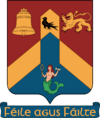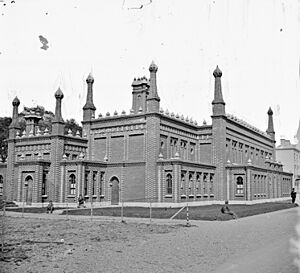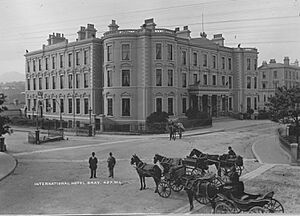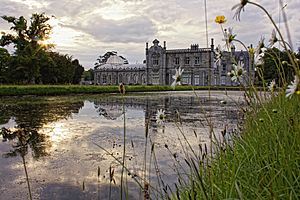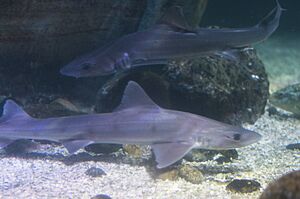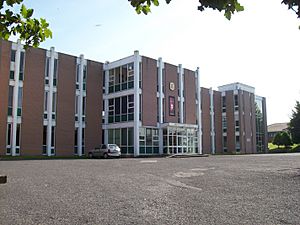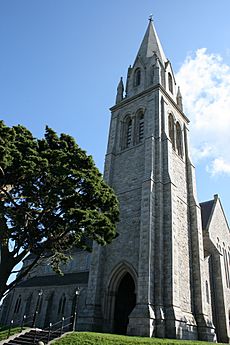Bray, County Wicklow facts for kids
Quick facts for kids
Bray
Bré
|
||
|---|---|---|
|
Town
|
||
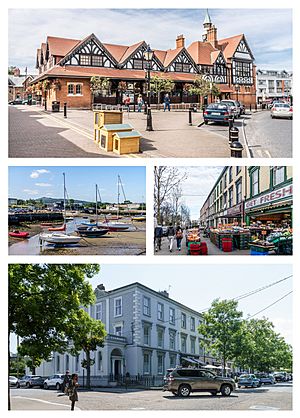
Clockwise from top: the Tudor Revival style Bray Town Hall; businesses on Goldsmith Terrace; period terraced homes on Quinsborough Road; boats in Bray Harbour
|
||
|
||
| Country | Ireland | |
| Province | Leinster | |
| County | County Wicklow, County Dublin | |
| Area | ||
| • Total | 9.9 km2 (3.8 sq mi) | |
| Elevation | 18 m (59 ft) | |
| Population
(2022)
|
||
| • Total | 33,512 | |
| • Rank | 10th | |
| • Density | 3,398/km2 (8,800/sq mi) | |
| Time zone | UTC+0 (WET) | |
| • Summer (DST) | UTC+1 (IST (WEST)) | |
| Eircode (Routing Key) |
A98
|
|
| Area code(s) | 01 (+3531) | |
| Irish Grid Reference | O264185 | |
Bray (Irish: Bré [bʲɾʲeː]) is a lively coastal town in north County Wicklow, Ireland. It's located about 20 kilometers (12 miles) south of Dublin city center on the east coast. Some parts of Bray even stretch into County Dublin.
With a population of 33,512 people (as of the 2022 census), Bray is the tenth largest urban area in Ireland. The town is home to Ardmore Studios, where many famous movies have been made. Bray also has some businesses and shops. Getting to Dublin from Bray is easy thanks to rail (DART), Dublin Bus, and major motorways like the M11 and M50.
Bray was first built as a special resort town in the 1800s. It became very popular as a seaside resort when the Dublin and Kingstown Railway reached it in 1854. Later, when people started traveling abroad more for holidays, Bray's popularity as a resort slowed down. However, it's still a favorite spot for day-trippers from Dublin, especially in the summer.
Contents
What's in a Name? The Story of Bray's Name
The name Bray comes from the Irish word Bré. We're not entirely sure what Bré means. Some people think it might have been an old name for the River Dargle or one of its smaller streams.
In the past, some thought the Irish name was Brí, meaning "hill," referring to Bray Head. However, this idea was later shown to be incorrect. The official Irish name, Bré, was finally chosen by law in 1975.
A Look Back: Bray's History
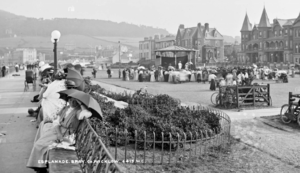
During the Middle Ages, Bray was on the southern edge of an area called the Pale. This coastal part was directly controlled by the English from Dublin Castle. Further inland, powerful Irish clans like the O'Toole and O'Byrne families ruled. Bray even appears on a 1598 map as "Brey." In 1627, the Killruddery Estate in Bray was bought by William Brabazon, 1st Earl of Meath.
The first railway in Ireland, the Dublin and Kingstown Railway, opened in 1834. It was extended to Bray in 1854. This railway helped Bray grow into a popular seaside resort. It was designed to be like English seaside towns such as Brighton. Many hotels and homes were built near the seafront.
A railway businessman named William Dargan built fancy Victorian Turkish baths in 1859. They were designed in a Moorish style and cost a lot of money back then. Sadly, they were taken down in 1980.
Bray was a very popular place from the 1860s onwards. It had small events like boat races, fireworks, and band concerts. However, Bray didn't manage to build bigger attractions like a pleasure pier or a concert hall. This led to its popularity as a resort declining in the early 1900s. After World War II, it had a brief comeback with British tourists. But when foreign travel became easier and cheaper, fewer people chose Bray for their main holiday. Still, many people from Dublin visit Bray for day trips.
Where is Bray?
Bray is located on the east coast of Ireland, just south of County Dublin. To the north, you'll find Shankill in County Dublin, and to the south is Greystones, County Wicklow. The village of Enniskerry is to the west, at the base of the Wicklow Mountains.
People in Bray enjoy sports like sailing, rowing, and swimming. The beach and seafront promenade are popular spots for both locals and visitors. Bray's promenade and south beach have a high standard, known as a Blue Flag.
The River Dargle flows into the sea at the north end of Bray. It starts high up in the Wicklow Mountains near Djouce. Bray Head is a hill at the southern end of the Victorian Promenade. You can find paths leading to its top and along the sea cliffs. The rocks of Bray Head are a mix of greywacke and quartzite. There's a large cross at the very top of Bray Head.
Bray's Weather
Bray has a mild oceanic climate, much like most of Ireland. This means it doesn't get too hot or too cold, and it rains throughout the year. However, the Wicklow Mountains protect Bray from strong winds, so it gets about 750 mm (30 inches) of rain each year. The sunniest months are usually May and June.
Getting Around Bray
By Train
Bray is part of the Irish Rail DART network. This train line goes north to places like Malahide and Howth, and south to Greystones. Bray is also on the main InterCity and Commuter rail lines. These connect north to Connolly Station in Dublin city center and further to Drogheda and Dundalk. To the south, the line goes through Arklow and Gorey all the way to Rosslare Europort.
Bray's train station is named after Edward Daly, a leader from the 1916 Easter Rising. Bray Station first opened on July 10, 1854.
By Road
Bray is located along the M11 motorway. This road connects to the M50 Dublin bypass on its northern side.
Several bus companies serve Bray, including Dublin Bus, Go-Ahead Ireland, and Bus Éireann. Dublin Bus and Go-Ahead Ireland are the main operators. For example, the 145 bus goes from Ballywaltrim (just south of Bray) to Heuston Station in Dublin, passing through UCD and the city center.
You can also catch an Aircoach service to and from Dublin Airport from Bray.
By Air
Dublin Airport is easy to reach via the M50 motorway. You can also take the Aircoach route 702. For private planes, Newcastle Aerodrome is the closest airfield, a short distance south of Bray.
Who Lives in Bray?
Bray has a growing number of people who live there permanently.
| Historical population | ||
|---|---|---|
| Year | Pop. | ±% |
| 1991 | 26,953 | — |
| 1996 | 27,923 | +3.6% |
| 2002 | 30,951 | +10.8% |
| 2006 | 31,901 | +3.1% |
| 2011 | 31,872 | −0.1% |
| 2016 | 32,600 | +2.3% |
| 2022 | 33,512 | +2.8% |
Fun Things to Do: Tourism in Bray
Bray has been a popular holiday spot since the early 1800s. Back then, it was known for being a favorite summer place for wealthy people from Dublin. It had many nice cottages, guesthouses, and furnished homes for visitors.
Today, Bray still has many hotels, guesthouses, shops, restaurants, and evening entertainment. You can find an 18-hole golf course, a tennis club, fishing spots, a sailing club, and horse riding nearby. Other fun places include amusement arcades and the National Sealife Centre.
Bray's beach is a mix of sand and shingle, stretching over 1.6 kilometers (1 mile) long. It's backed by a lovely promenade and Bray Head, which rises 241 meters (791 feet) from the coast. From Bray Head, you can see amazing views of the mountains and the sea. A concrete cross was put at the top of Bray Head in 1950.
Bray is a great starting point for walkers. Its 1-mile (1.6 km) long promenade goes from the harbor, where you can see mute swans, to the base of Bray Head. From there, a path leads to the summit. Another popular walk is the 7-kilometer (4.3-mile) Cliff Walk along Bray Head to Greystones.
In 2010, Bray was named the "cleanest town in Ireland" in a survey. In 2023, Time Out magazine even called Bray one of the most underrated travel destinations in the world!
Places to Visit
Some interesting places to visit in Bray include:
- Killruddery House: An old mansion that looks like an Elizabethan-style house. You can visit it during the summer.
- Bray Head: A hill and headland with several walking trails and great views.
- Raheen-a-Cluig: A medieval church on the north side of Bray Head, considered a national monument.
- Other old churches like the Fassaroe Cross (from the 12th century), the Holy Redeemer Church, Bray (1792), and the Gothic Revival churches of Christ Church (1863) and Bray Methodist Church (1864).
Festivals and Events
Bray hosts many fun events throughout the year:
- The Bray St. Patrick's Carnival and Parade celebrates Saint Patrick's Day.
- The Killruddery Film Festival, a silent film festival, takes place in Killruddery Gardens.
- Bray Jazz Festival happens every May bank holiday weekend, featuring jazz and world music artists.
- The annual Bray Summerfest runs for six weeks in July and August. It offers free entertainment, live music, markets, sports, and carnivals. Famous performers like Mundy and Mary Black have played there.
- The Bray Air Display is an annual air show over the beach, usually in late July or early August.
- Hell & Back is an adventure race held at Kilruddery Estates.
- The 10 km (6.2 miles) Cliff Run from Bray to Greystones is an annual race around Bray Head Mountain.
Food and Drink
Bray has many pubs and restaurants. The first Porterhouse bar, which brews its own ales and stouts, is located here. In 2010, the Lonely Planet Guide called the Harbour Bar in Bray the "Best Bar in the World."
You'll find twelve fully licensed restaurants, several cafes, and fast food places in Bray. A study in 2015 found that Bray had one of the lowest numbers of fast food outlets per person compared to other Irish towns.
Culture and Arts in Bray
Film
Bray is home to Ireland's oldest film studios, Ardmore Studios, which opened in 1958. Famous movies like Excalibur, Braveheart, and Breakfast on Pluto were filmed there. Parts of Neil Jordan's 2012 film Byzantium were also shot in Bray. Neil Jordan's 1991 film The Miracle is even set in Bray.
Theatre and Books
Bray has several theatre groups, including Bray Arts and Square One Theatre Group.
Many famous writers have lived in Bray, such as James Joyce, Sir Arthur Conan Doyle, Molly Keane, and Neil Jordan. There's a Carnegie Library on Eglinton Road, built in 1910, and another library in the Ballywaltrim area.
News and Radio
The Bray People newspaper covers local news. The Wicklow Times (North Edition) is a free newspaper also focused on the area. East Coast FM is the local radio station.
Music
Musicians connected to Bray include Mary Coughlan, Maria Doyle Kennedy, Fionn Regan, and Hozier.
The singer Sinéad O'Connor lived in Bray for several years. After she passed away in London, her funeral procession was held on Bray seafront in August 2023.
Sports in Bray
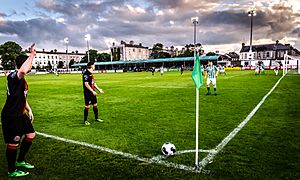
Bray is home to the League of Ireland football club Bray Wanderers, who play at the Carlisle Grounds. There are also schoolboy football clubs like Ardmore Rovers and Wolfe Tone F.C. The local Gaelic Athletic Association (GAA) clubs are Fergal Og's and Bray Emmets. Bray Emmets, founded in 1885, hosts the annual All-Ireland Kick Fada Championship.
You'll find several golf clubs and pitch & putt courses in the area, including Bray Golf Club. Bray also has a Bowling Club and a 10 Pin Bowling Alley.
Fishing is popular in both the River Dargle and along the coast. There are local clubs like Bray Head Fishing Club. Other sports clubs include Bray Wheelers Cycling Club, Brennanstown Riding School, Bray Sailing Club, Wicklow Lawn Tennis Club (founded in 1894), and Bray Hockey Club.
In August 2012, thousands of people gathered on the seafront to welcome Olympic boxing champion Katie Taylor home from London.
Learning in Bray: Education
Bray has about 13 primary schools, including national schools (like Saint Cronan's Boys' National School), Irish-speaking schools (gaelscoileanna like Gaelscoil Uí Chéadaigh), and a co-educational day school (St. Gerard's School).
Secondary schools in the area include Saint Brendan's College, Loreto Secondary School, St. Kilian's Community School, and Presentation College, Bray. There are also schools for learning English as a foreign language and a college for further education called Bray Institute of Further Education.
Famous People from Bray
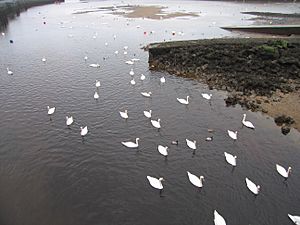
Many interesting people have lived in Bray, including:
- Eamon de Buitlear: A writer, filmmaker, and traditional Irish musician.
- Conrad Burke: A physicist and entrepreneur.
- Seamus Costello: A founding member of the Irish National Liberation Army.
- Suzanne Crowe: President of the Medical Council of Ireland.
- Mary Coughlan: A singer who lives in the town.
- S.M. Cyril: An Irish nun and educator based in India.
- Fergal Devitt: A professional wrestler in WWE.
- Jordan Devlin: A professional wrestler in WWE.
- Hozier: A famous singer and songwriter.
- Eddie Jordan: A former racing driver and founder of Jordan Grand Prix.
- Ed Joyce: A professional cricketer.
- James Joyce: A world-renowned writer.
- Maria Doyle Kennedy: A singer and actress who lived in Bray as a child.
- Denzil Lacey: A radio presenter.
- Sheridan Le Fanu: A writer of gothic horror and mystery novels.
- Thomas Langlois Lefroy: A politician and judge.
- Keith Nolan: A professional golfer.
- Dara Ó Briain: A comedian and television host.
- Sinéad O'Connor: A singer who lived in the town.
- Cearbhall Ó Dálaigh: The fifth President of Ireland.
- Fran O'Toole: A former lead singer in The Miami Showband, who tragically died in July 1975.
- Gary O'Toole: A former Irish Olympic swimmer from Bray.
- Darren Randolph: A goalkeeper for the Republic of Ireland national football team.
- Fionn Regan: A musician.
- Lennox Robinson: A dramatist and poet.
- Katie Taylor: A world, European, and Olympic boxing gold medalist.
- Laura Whitmore: A TV personality and presenter.
- William Wilde and Jane Wilde: The parents of Oscar Wilde, who built properties in Bray in 1863.
Sister Cities
Bray has special "twin town" agreements with:
- Bègles, France
- Dublin, California, United States
- Würzburg, Germany
Images for kids
See also
 In Spanish: Bray (Irlanda) para niños
In Spanish: Bray (Irlanda) para niños


